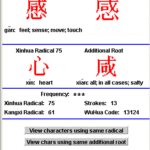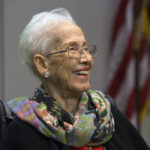Did you know you see Asian-American heritage in action every day?
by Frances Kai-Hwa Wang, AAV Contributing Editor
her*i*tage (her-i-tij) n.: 1. property that may be or has been inherited. 2. value or traditions passed from earlier generations.
Imagine this day:
You are sound asleep in bed and suddenly you are woken up by an earthquake. Your mommy tells you it was 7. 0 on the Richter scale and that the epicenter was on the other side of town. You get dressed in a cotton T-shirt and blue jeans. You tie your hair back with a bandana. And put on a pearl necklace that your grandmother gave you. You go down to breakfast and have oatmeal with brown sugar sprinkled on top and a glass of orange juice. You ride your horse to school. You put your feet in the stirrups and use your compass to find your way.
Today, you have chess class before school. At school, you read a new book, Horrible Harry and the Green Slime, and write in your journal. In math, you learn to add with zeros. At choice time, you work on the computer. You play a new software by putting in a CD-ROM. In art class, you make tie-dye T-shirts. At recess, you play yo-yo or cat’s cradle with your friends. You play rock-paper-scissors to see who goes first. At lunch, it is raining, so you stay inside and play Chutes and Ladders or Parcheesi.
After school, your mommy picks you up and takes you with her to the polling booth because it’s election day and she has to vote. It’s still raining, so you use your umbrella when you get out of the car. When you get home, you start to play Nintendo or Game Boy, but your mommy says that you have to do your homework first, of course. After homework, you go out to the park to fly your kite. Afterwards you might watch Jackie Chan Adventures or Sailor Moon cartoons on TV. You help your mommy and daddy push the wheelbarrow as they work in the garden. Then you have dinner: Teriyaki Burgers and pineapple juice. Mommy makes a cherry pie for dessert, your favorite.
Then you go to soccer practice. After soccer practice, you have martial arts class. After martial arts class, you have hula dancing lessons. After your lessons are all finished, it’s just starting to get dark—did I mention that it’s the Fourth of July?—so your family goes out to watch fireworks. Afterwards, you go home, take a bath, shampoo your hair, and put on your favorite Hello Kitty pajamas. You ask to watch your Mulan DVD, but instead, Daddy reads you Cinderella for your bedtime story.
Wow, what a day! But without the contributions of Asia and Asian Americans, none of this would be possible. It would be a very different world.
Why?
Because one of the very coolest things about America is that America is a nation of immigrants. Except for Native Americans, everyone who lives here is has families that started somewhere else. Some came 200 years ago, some 100 years ago, some 30 years ago, some 5 years ago, and some yesterday. It does not matter how long ago one’s family came. By living and working in America, we are all making America what it is. Furthermore, American culture is a mixture of all the different cultures and customs of people that have come over the years. All the pieces of American culture, like its people, have roots somewhere else; and all of America’s history has been made by people who either came or whose family came from all around the world.
Asian Pacific American Heritage Month is a time to celebrate the contributions of Asian Pacific Americans to America’s history and culture, and the links we all have to Asia and the Pacific. Here are just some of the many cool people and things in America that you maybe didn’t even know were part of our Asian-American heritage. There are lots of other things you might see and do everyday. Can you think of more to add to our list, too? E-mail us!
|
Pop Quiz!
“Yo-Yo” is
 A) What friends of the great Chinese-American cello player Mr. Ma call him? A) What friends of the great Chinese-American cello player Mr. Ma call him?
B) A fun spinning toy on a string that began in the Philippines and was used as a weapon
C) All of the above!

|
Famous Asian Pacific Americans
- Apolo Ohno: Olympic Gold & Silver Medalist, speed skating
- Angela Perez Baraquio: First Asian American Miss America 2001
- Bruce Lee: Martial Artist and Actor
- Sarah Chang: Violinist
- Norman Mineta: US Secretary of Transportation; formerly mayor of San Jose, US Congressman, and US Secretary of Commerce
- Elaine Chao: US Secretary of Labor
- Gary Locke: Governor of Washington State
- Dr. Subrahmanyan Chandrasekhar: Nobel Prize winner, evolution of stars, led to modern astrophysics
- Ellison Onizuka: Astronaut
- Kalpana Chawla: Astronaut, first Indian American woman in space
- Jerry Yang: Yahoo! Founder
- Dr. David Ho, MD: Medical researcher and 1996 Time Man of the Year
- Kristi Yamaguchi: Olympic Gold Medalist, figure skating
- Tiger Woods: Golf Pro
- Michael Chang: Tennis Pro
- Benny Agbayani: Baseball Player, Colorado Rockies
- Akebono (Chad Rowan): Sumo Wrestler (retired)
- Betty Ong: Flight Attendant who called authorities from American Airlines 11 on 9/11
- Dustin Nguyen: Actor
- Tia Carerre: Actor
- Dean Cain: Actor
- Michelle Kwan: Olympic Silver and Bronze medalist, Figure skating
|

Japan’s Hello Kitty plays in the Cinderella story, which was told in China long ago
|
Fun Stuff We Do
- Story of Cinderella: China
- Chutes and Ladders: Originally a Hindu religious game
- Parcheesi: India 1500’s
- Kite: China c. 1 AD (popularized in US in 1876)
- Chess: India c. 550 AD
- Hello Kitty: Japan
- Surfing: Hawai’i, probably combined from two Polynesian and Tahitian sports
- Cat’s Cradle: Southeast Asia (imported to Europe 1600’s)
- Rock Scissors Paper: Japan
- Martial Arts: Kung Fu, Tai Kwon Do, Akido, Karate, Judo, Sumo
- Yoga: India
- Nintendo: Japan 1980’s
- Sailor Moon: Japan
- Soccer: China played a “football” game like soccer over 2,300 years ago!
|

Fortune Cookies
Invented in Los Angeles 1918
|
Made in America: Asian American Contributions
- 100th Infantry Battalion and 442nd Regimental Combat Team: all-Japanese American units, most decorated units in World War II.
- Bing Cherries: Developed by Ah Sit Bing in Oregon
- Frost-resistant Oranges: Developed by Lue Gim Gong in Florida that helped build a great citrus industry
- Wave Field at University of Michigan: designed by Maya Lin (also Vietnam War Memorial)
- Sagwa the Chinese Siamese Cat: written by Amy Tan, a Chinese American
- Cleveland’s Rock and Roll Hall of Fame: designed by architect IM Pei
- Helped build the Transcontinental Railroad 1865-1869
- Farming: developed Hawaii’s sugar cane and pineapple plantations, drained the swamps in California’s San Joaquin delta region and turned it into farmland, farmed in the South after the Civil War
- “Manilamen developed shirimping and fishing villages in Louisiana territory in 1763, introduced sun-drying process for shrimp
- Mulan film: voices of Ming-Na Wen, BD Wong, George Takei
- Hula: Native Hawaiian dance form
- Computer Industry in Silicon Valley
- Fought for their rights: US vs. Wong Kim Ark 1898 grants US Citizenship for all children born in the US
- Built communities in America like Chinatown, Little India, Japan Town, Little Saigon
- Brought cultural festivals like Cherry Blossom Festival, Lunar New Year, Obon Festival, Dragon Boat Races, etc.
- Scooby-Doo and a lot of other famous cartoon dogs were created by Iwao Takamoto, a Japanese American
|

Compact Disc (CD)
Japan 1982 Sony
|
Imports and Inventions
- Papermaking: China 105 AD (or 200 years earlier)
- Printing (Movable type): China 1045 AD (Gutenberg developed in Europe 300 years later)
- Gunpowder: China c. 800 AD
- Compass: China c. 300 AD
- Umbrella: China 386-532 AD
- Zero: China 400 BC
- Seismograph: China Han Dynasty (invented in Europe 1500 years later)
- Wheelbarrow: China
- Stirrups: China
- Silk: China
- Tie-dying: India c. 600 AD
- Batik: Indonesia
- Pajamas: India
- Bandana: India
- Sony Walkman: Japan 1979
- Compact Disc (CD): Japan 1982 Sony
- CD-ROM: 1985 Sony
- DVD: Japan 1996 Sony
- Cultured Pearls: China c. 800 AD, Japan 1888 first pearl farm
- Cotton: India discovered and cultivated 5000 BC, also developed calico, chintz, madras, seersucker
- Paisley: India Kashmir
- Indigo dye for blue jeans: India harvested since 4000 BC (Europe started importing 1300’s)
|

2-in-1 set of color-in stickers / tattoos (a Tahitian word!) with characters from Pokemon (from Japan, of course!)
|
Borrowed Words
- Bangle: Hindi bangri (Indian bracelets)
- Brainwashing: Chinese hsi nao
- Bungalow: Bengali bangla (Bengal)
- Orangutan/orang-outang: Malay
- Tattoo: Tahiti
- Jungle: Sanskrit
- Catamaran: Tamil
- Loot and Dunagaree: Hindi/Urdu
- Ketchup: Malay koetsiap (seafood sauce)
- Shampoo: Hindi capo capna (head massage)
- Compound: Malay
- Cheetah: Sanskrit
- Boondock: Tagalog
- Taboo: Tonga
- Ukelele: Polynesian
- Tycoon: Cantonese ta kiun (great prince)
- Gung ho: Chinese zhong guo gung yie hou tsou shi Chinese Industrial Cooperatives Society. In 1942 US Marine Corps Lt. Col. Evans Carlson turned gong “work” and ho “together” into “work together”–Chinese words, but not really a Chinese phrase.
For More Information, Check Out These Readings
|



















